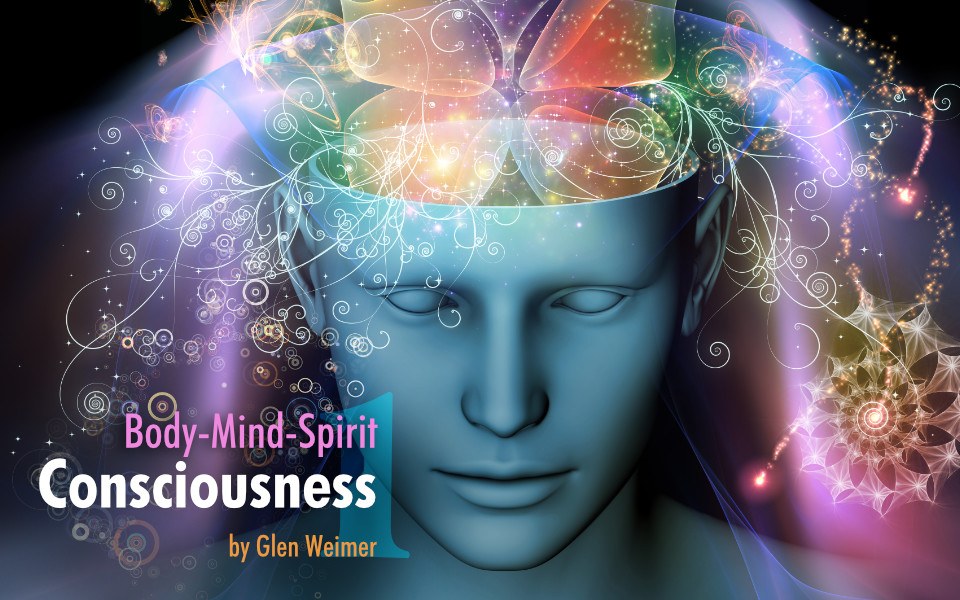Intro
I have been struggling for many weeks with the next series of 6+ blogs. I’ve been working on them simultaneously in an attempt to go deeper than I’ve been able to before with information that builds a more comprehensive understanding of consciousness, movement, and form. I have multiple blogs and numerous sections within each that can easily be shuffled and presented in any number of ways. The problem is that all the pieces of the puzzle interconnect flawlessly, so you need to understand the whole to appreciate the significance of each part.
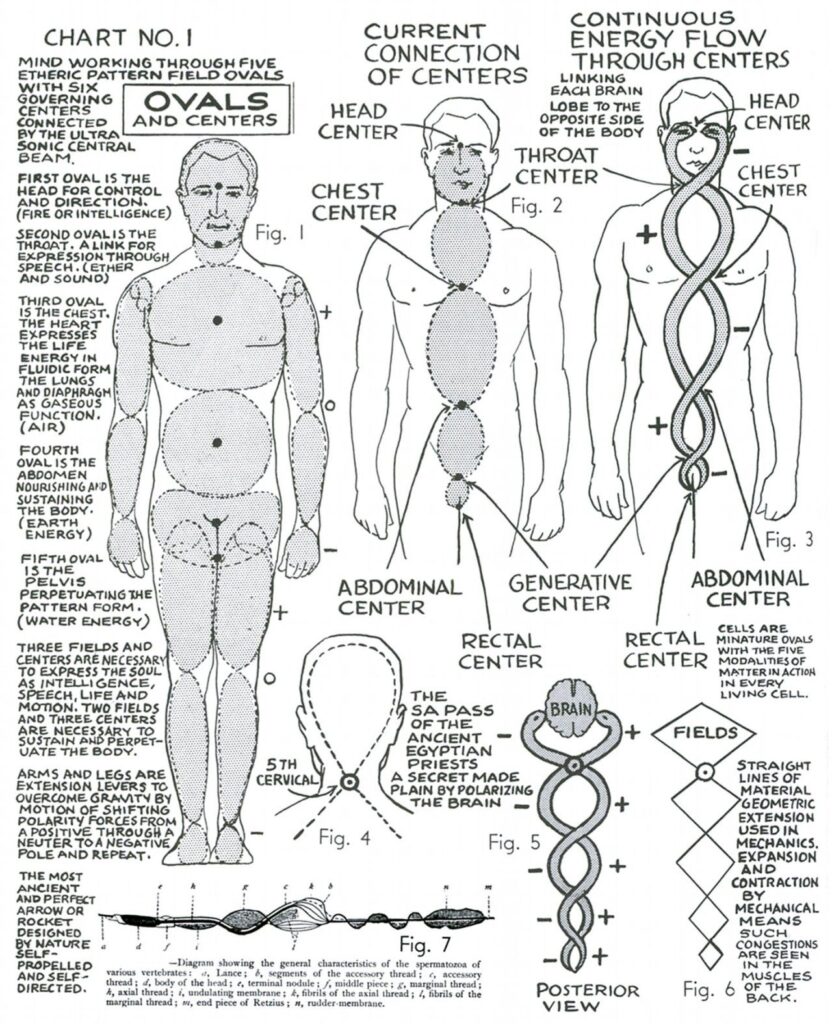 Dr. Stone’s writings on Polarity Therapy are often a nightmare for beginning students because he seems to present all his information at once to illustrate exactly this type of interconnectedness. On the other hand, this is precisely what makes it so magical for advanced students versed in multiple scientific and esoteric areas. His style was typical of Hermetic or syncretic writing from antiquity through the early 20th century. As I attempt to put all of this into words I have a new appreciation for Dr. Stone’s conundrum.
Dr. Stone’s writings on Polarity Therapy are often a nightmare for beginning students because he seems to present all his information at once to illustrate exactly this type of interconnectedness. On the other hand, this is precisely what makes it so magical for advanced students versed in multiple scientific and esoteric areas. His style was typical of Hermetic or syncretic writing from antiquity through the early 20th century. As I attempt to put all of this into words I have a new appreciation for Dr. Stone’s conundrum.
The challenge is that when you experience the world from a holistic perspective, you have a visceral ‘knowing’ and can appreciate the full tapestry of interconnections. In fact, the broader and more diverse your studies, the more you see cross-overs of information, dots that have yet to be connected. We live in a world of uberspecialization, so often the language, or metaphors as Joseph Campbell would say, are different in each system. What I am speaking of is more than simply a right-brain (creative, non-linear) versus left-brain (logical, linear) understanding, but rather a full-brain synchronization seeing the unity of parts within a greater whole. Reading about these interrelationships can actually help entrain us into full-brain integration, building brand new neural pathways.
So, how to explain this in a logical, sequential manner that conforms to the limits of spacetime? The two pieces, in all my writings, that I’ve chosen to build upon are felt-sense experience and the 3-branch Polyvagal Autonomic Nervous System. As such I will bring them up repeatedly because I’m hanging this series on these ideas. Besides, there are still far greater depths to be plumbed there.
All of that is to say, please bear with me as I attempt to explain the fabric of reality and consciousness from my unique perspective. Not too big an undertaking, right?
Language As Metaphor
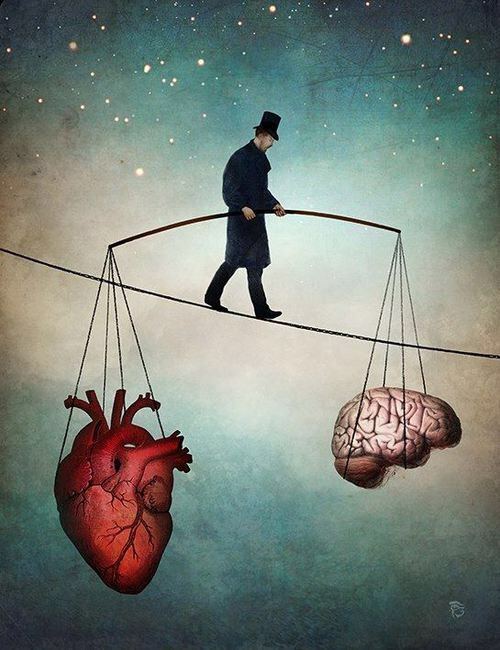 Over the past 5 blogs, I’ve discussed consciousness, our subtle perceptions, and experiences that are hard to put into words — the ones most often described through art, metaphor, poetry, and song; the background or connotation of the world we experience. I’ve contrasted that with the foreground or denotation which we can see and touch and quantify with scientific devices — the world that we normally acknowledge as ‘real’.
Over the past 5 blogs, I’ve discussed consciousness, our subtle perceptions, and experiences that are hard to put into words — the ones most often described through art, metaphor, poetry, and song; the background or connotation of the world we experience. I’ve contrasted that with the foreground or denotation which we can see and touch and quantify with scientific devices — the world that we normally acknowledge as ‘real’.
Language is important in this process because when we change the language and introduce new terms, it changes the way that we perceive what’s going on, what we think about, what we experience, and the insights we gain. Joseph Campbell talked about how myth and metaphor have been used historically to reveal layers of meaning often-times hidden. Language itself IS metaphoric, it can only ever ‘kinda sorta’ point towards what we are truly trying to convey.
Consciousness
When we think about consciousness most of us think about being awake versus asleep, that’s the dividing line we most often use — between our Conscious Mind and Dreaming or Unconscious Mind. We also know there’s a Waking Unconscious we associate with our Subconscious Mind. It’s the one that gets us to do things we probably shouldn’t — the one that walks our body to the fridge at midnight for some Ben & Jerry’s or is actually driving the car on that six-hour road trip where we can’t seem to recall anything that happened along the way.
 If you’ve ever meditated or done psychoactive drugs you recognize there are yet other ‘trippy-things’ the brain does when it’s in an expanded state of awareness. Anyone who’s done either undoubtedly finds these the most interesting of all.
If you’ve ever meditated or done psychoactive drugs you recognize there are yet other ‘trippy-things’ the brain does when it’s in an expanded state of awareness. Anyone who’s done either undoubtedly finds these the most interesting of all.
In this blog I’d like to talk about all of it, focusing on subconscious, conscious and superconscious states. Then, within the next three, we’ll look at brainwave frequencies, heart-brain coherence, and 2-directions that consciousness can travel in — outward, through the 5-senses into the world of spacetime, or inward, ignoring our senses, away from our awareness of the physical world, on a spiritual journey of expanded states towards unity or undifferentiated consciousness.
Polyvagal ANS
We can’t talk about embodied consciousness without the Autonomic Nervous System which plays a pivotal role in our states of consciousness.
The Autonomic Nervous System (ANS) controls all subconscious, automatic functions of the body. Its primary function is to keep us alive. It controls our entire physiology and every organ system; which includes all the muscles, bones, and connective tissues.
In 1994 Dr. Stephen Porges developed a Polyvagal Theory of the ANS with 3-branches that we draw upon based on our level of safety or threat. (see my Polyvagal blog for greater detail)
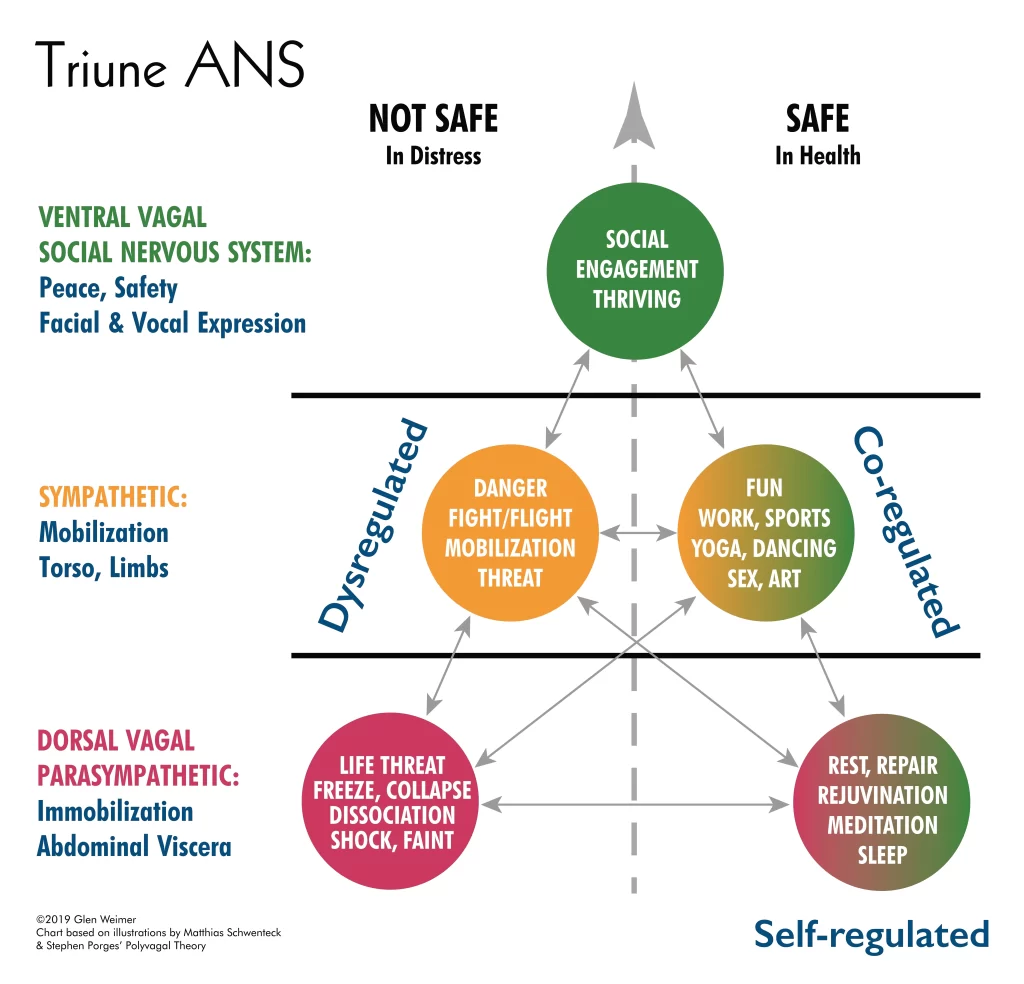 The Ventral Vagal (VVC) branch or Social Nervous System requires a perception of safety which then enables us to connect and bond with others. In this state, our energy and blood flow is centered in our core for tissue repair and recovery and our breathing and heart rate are slow and measured. Our digestive system is engaged in breakdown, assimilation, and elimination.
The Ventral Vagal (VVC) branch or Social Nervous System requires a perception of safety which then enables us to connect and bond with others. In this state, our energy and blood flow is centered in our core for tissue repair and recovery and our breathing and heart rate are slow and measured. Our digestive system is engaged in breakdown, assimilation, and elimination.
Additionally, and most importantly for this blog, I identify VVC as the doorway to mediative and higher states of consciousness. Safety, both enables us to engage with our outer world as Dr. Porges states, but also, knowing that our body is safe, allows us to go deep into altered states. We cannot do this without an internal felt-sense of safety. Without Ventral Vagal co-regulating both our Dorsal Vagal and Sympathetic Nervous Systems, we are in continual self-protection mode.
If we feel threatened in any way, we engage the Fight or Flight response of the Sympathetic Nervous System (SNS); activating the body to defend/attack or run away from the perceived threat. If our nervous system determines that there are no good options to avoid that threat we engage the dysregulated Dorsal Vagal (DVC), our Freeze/Collapse response. This is the most primitive part of our reptilian brain. In this state, we believe death is imminent so we numb and dissociate from our body as we surrender to complete overwhelm.
Neuroception
 Neuroception is a term Dr. Porges coined to describe the mechanism that drives our ANS response. Different from perception, this occurs far below our conscious thoughts. It mobilizes all body functions necessary to meet that challenge. Author Deb Dana says, “before the brain understands and makes meaning of an experience, the autonomic nervous system, via the process of Neuroception, has assessed the situation and initiated a response.”
Neuroception is a term Dr. Porges coined to describe the mechanism that drives our ANS response. Different from perception, this occurs far below our conscious thoughts. It mobilizes all body functions necessary to meet that challenge. Author Deb Dana says, “before the brain understands and makes meaning of an experience, the autonomic nervous system, via the process of Neuroception, has assessed the situation and initiated a response.”
Neuroception analyzes everything we see, smell, hear and feel. It compares this current data to previous experiences of potential danger and engages a full-body multisystem response all before we are aware of any conscious impressions. When we meet a person we often unknowingly scan their face, voice, and subtle gestures to determine how we should respond — are they friend or foe?
Conscious Mind
Now we can begin our dive down the rabbit hole. Let’s start with the conscious mind because that’s what we usually think of when we’re pondering consciousness, it is our awareness, our mind, our ego state, and our self-identity. Typically, the conscious mind focuses our attention out, through the 5-senses to the physical world. The conscious mind is an extraordinary focusing tool. We can aim it in whatever direction we choose and tether it to that; including moving inward toward our body sensations or out into expanded awarenesses.
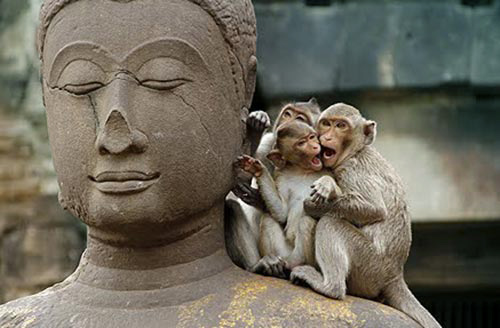 But, … that’s often easier said than done. Anyone who’s tried to keep their attention on a single thing for any length of time knows that the mind loves to wander. We quickly find that we’ve slipped into an unconscious, autopilot state that is now off galavanting everywhere but where we’re attempting to focus. Eastern meditation traditions refer to this as monkey mind and liken it to wild stampeding horses.
But, … that’s often easier said than done. Anyone who’s tried to keep their attention on a single thing for any length of time knows that the mind loves to wander. We quickly find that we’ve slipped into an unconscious, autopilot state that is now off galavanting everywhere but where we’re attempting to focus. Eastern meditation traditions refer to this as monkey mind and liken it to wild stampeding horses.
I propose that this is because the conscious mind is a backup system to the Autonomic Nervous System’s Neuroception. Not fully trusting that Neuroception caught EVERY threat, the conscious mind races back and forth, from the past to the future. We rehash the argument we had with our husband over breakfast to figure out how to ‘win’ when we start back in over dinner. We project every problem scenario and possible pitfall into a ‘multiverse’ of possible futures to try to solve each one before they have the chance to manifest.
The conscious mind has a really hard time staying in the present. Anyone who’s tried to meditate in their conscious mind knows that it’s all over the place. For me, that is never the ‘room in the house’ to meditate in! We’re thinking about all of our interactions from earlier that day, running our ‘To-Do’ list, shopping for groceries, and re-hashing every conversation (even while we’re in the middle of them) — all to assure our safety. And not just physical safety, we are concerned with how others perceive us, what they may tell others about us, how we feel about ourselves, our social standing, economic security, and the health of our relationships. We run it all through our lower chakras because any of those areas and more can affect the quality of our life.
 For the conscious mind to settle we have to be in our Ventral Vagal, Safety mode. As soon as the nervous system down-regulates the conscious mind can go ‘off patrol duty’ and FOCUS. It is impossible to focus the mind when we are fearful or anxious. For this reason, I feel the conscious mind is mostly a slave to our ANS states.
For the conscious mind to settle we have to be in our Ventral Vagal, Safety mode. As soon as the nervous system down-regulates the conscious mind can go ‘off patrol duty’ and FOCUS. It is impossible to focus the mind when we are fearful or anxious. For this reason, I feel the conscious mind is mostly a slave to our ANS states.
“Just as thoughts are the language of the brain, feelings are the language of the body. And how you think and how you feel create a state of being. A state of being is when your mind and body are working together. So your present state of being is your genuine mind-body connection… So thinking creates feeling, and then feeling creates thinking that’s equal to those feelings. It’s a loop…Eventually, when this loop of thinking and feeling and then feeling and thinking has been operating long enough, our bodies memorize the emotions that our brains have signaled our bodies to feel. The cycle becomes so established and ingrained that it creates a familiar state of being—one based on old information that keeps recycling.” ~ Dr. Joe Dispenza, You Are the Placebo
We can, by force of will, attempt to wrestle our conscious-mind free of our subconscious drives, to assume control, a 3rd Chakra approach that’s doomed to fail. You might consider this an inner-masculine sledgehammer approach. I recall many mediations early-on where I spent the entire time screaming at ‘everybody up there’ to just shut up. Alternatively, we can bring all 3-states — conscious, subconscious, and superconscious into alignment, which you might consider a gentler inner-feminine method. By stepping out of our conscious mind (to one of the other rooms), we get to focus instead either on a polarized oscillation (body-consciousness), like the rhythm of the breath or other body fluctuations, repetitive chanting, or the tempo of a drum—1, 2, 1, 2, 1, 2; or conversely on a unity, a singularity (superconsciousness) like an inner stillness or space, the 3rd Eye, a candle flame, or felt-sense of unconditional love. (more on this in BMS 4: Direction)
Body-Mind
When we talk about our subconscious mind, we’re also talking about the body-mind which is the part of our consciousness focused on the rhythmic oscillations of our organs and organ systems — the polarity relationship of push-pull, expansion-contraction. The opposing forces of Yin and Yang, masculine-feminine, day-night in our outer world all reflect the inner opposition that body-consciousness experiences in all its tissue respirations. Each organ system of the body has a motility that is rhythmic, each with its own tempo, and those rhythms within us ‘hypnotize’ consciousness onto this planet and into spacetime.
3-Rhythms & Body Consciousness
Fundamentally, our bodies have 3-primary rhythms out of which all of the other rhythms of the body arise. The harmony of the 3-Primary Rhythms: Breath, Pulse, and Fluid-Tide, sustains different aspects of our health, it’s like three dancers moving to the beat of different drummers, but together creating a coordinated masterwork.
We all started out as a single cell, one sperm and egg coming together to form a zygote, which then began to divide, not like a mathematical formula but a living breathing undulating bounded fluid-body that literally pulled itself apart (1 cell becoming 2, 4, 8, 16, etc.). And for the first four weeks of life, that’s all we were, this primary rhythmic undulation of dividing and differentiating cells. What consciousness there was within these cells, was focused into this initial primary respiration, an undulation of bounded fluid. This was the inception of body-consciousness, recording ALL of its felt-sense experiences in cellular memory.
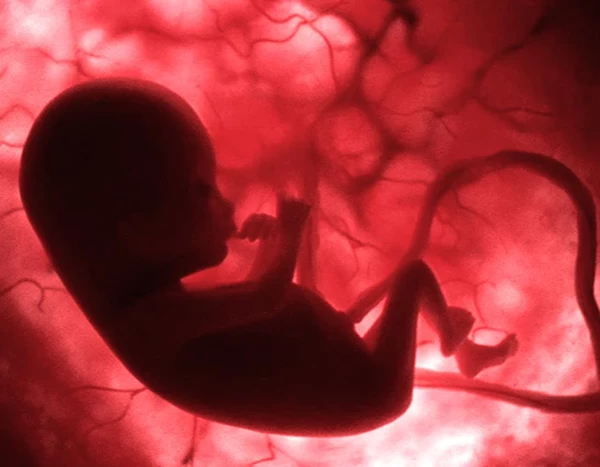
Even before solid structures began to form, there was this primary pulsation. It’s the first rhythm of consciousness that comes in and it’s the last rhythm of consciousness to leave when we die. All that we are exits in this slow steady oscillation, the slowest of our body-rhythms. So, as it divides it establishes a central axis, differentiating along a centerline that will gradually form into the brain, spinal cord, and the cerebral spinal fluid environment it swims in. The movement of every cell in our bodies rides this tidal flow throughout our entire life. As the old cranial osteopath would say, “everything rides the tide”. It is the Grand Conductor that orchestrates all body-rhythms.
For the first four weeks of fetal development, we live in this interesting world where that’s all we are, this single rhythm. I postulate that consciousness at this very early stage of development is really fluctuating between the polarities of rhythmic motion (spacetime) and a still-point singularity of ecstasy (undifferentiated consciousness), and then coming back into rhythm and differentiation, then back again into still-point and organization.
And then at week four, the heart, which has been developing just above the head, folds into the chest cavity and ignites. Now, we have a secondary rhythm, the beating of the heart, which is a distinctly different pulsation — much faster and more staccato than the slow fluidic primary respiration. For the next eight months, we ARE these two rhythms, recording everything that we and mom jointly experience through our felt-sense. This ‘me-mom’ is a unit with no differentiation. With each rhythmic beat, we are stretching our perceptions outward using our nascent central and peripheral nervous systems, and the body chemistry we share with mom. Body-consciousness is gathering data to prepare us for the kind of world we’ll be entering and recording all the traumas and stresses over the course of our ‘me-mom’ gestation.
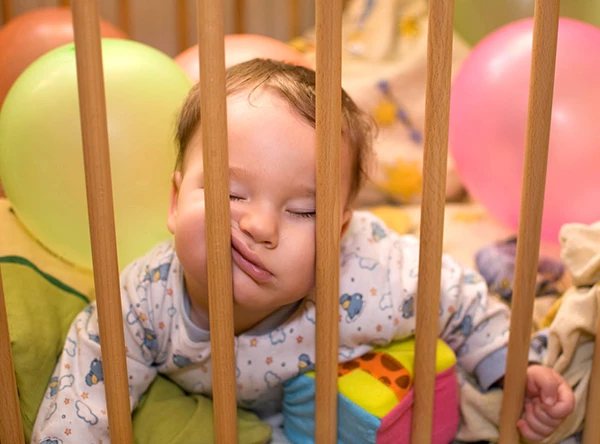 Then finally, eight months later, we come out into the world and take our first breath which ignites our third rhythm, the one that we have most conscious control over, the rhythm of the breath. Its tempo is slower and less staccato than the cardiac pulse but faster than the fluid-tide.
Then finally, eight months later, we come out into the world and take our first breath which ignites our third rhythm, the one that we have most conscious control over, the rhythm of the breath. Its tempo is slower and less staccato than the cardiac pulse but faster than the fluid-tide.
Although it is generally an unconscious rhythm, when we take conscious control over our breathing we can influence both of the other two which affects our Autonomic state, thereby how we feel and experience our world.
I love this picture, it so beautifully depicts us coming up against the first limitations of our external world; the difference between inner and out reality couldn’t be more stark.
Childhood Consciousness
 Infants spend the majority of their first 2-years in a dreamlike quasi-unconscious trance state, gradually beginning to focus more and more externally through their ANS. Until the age of 6, children are mostly functioning in Delta and Theta brain states. In adults, we associate these with deep unconscious sleep, and that transition state or light sleep respectively. Both are states more oriented to our inner world of our body-consciousness or unconscious mind. Between 5 and 8 years, children transition into a more analytical, externally focused state of awareness. For this reason, a great deal of sub- or body-conscious patterning happens from conception through early childhood. It is also a time for rapid learning, development of gross and subtle motor skills, language(s), and social interaction. The subconscious is a rapid superlearning machine. In this state, young children also don’t differentiate between the ‘real’, imaginary, and non-physical worlds.
Infants spend the majority of their first 2-years in a dreamlike quasi-unconscious trance state, gradually beginning to focus more and more externally through their ANS. Until the age of 6, children are mostly functioning in Delta and Theta brain states. In adults, we associate these with deep unconscious sleep, and that transition state or light sleep respectively. Both are states more oriented to our inner world of our body-consciousness or unconscious mind. Between 5 and 8 years, children transition into a more analytical, externally focused state of awareness. For this reason, a great deal of sub- or body-conscious patterning happens from conception through early childhood. It is also a time for rapid learning, development of gross and subtle motor skills, language(s), and social interaction. The subconscious is a rapid superlearning machine. In this state, young children also don’t differentiate between the ‘real’, imaginary, and non-physical worlds.
Many people struggle to remember their early childhood. I believe this is because we were using consciousness very differently back then. I can distinctly recall my first set of crayons, they were huge in my hands and one side was flat so they didn’t roll. What is distinct about this memory and others from my earliest years is that I had a multi-sensory perception of those crayons and my world. I saw-felt-smelled-tasted them viscerally through my whole being. I think that as we get older and shift more fully into our ‘normal’ waking conscious mind we lose touch with how differently we processed the world as kids. It was simultaneously a sub- and superconscious state.
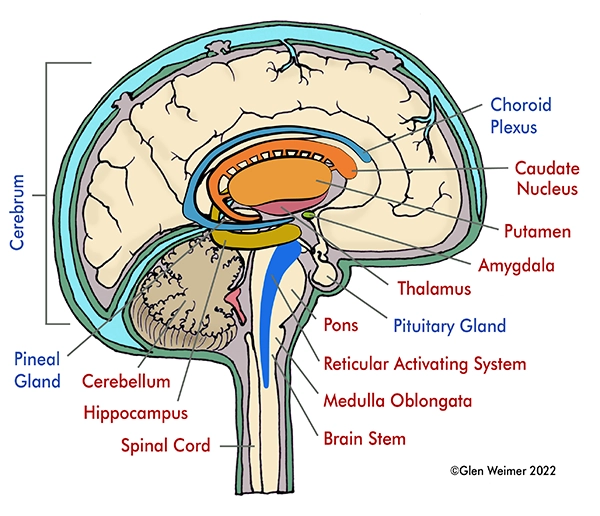 Subconscious
Subconscious
Subconscious activity is located in the most primitive parts of our innermost brain; such as the brain stem, medulla oblongata, pons, and midbrain. Additionally, it includes the reticular activating system (RAS), limbic system (including thalamus, amygdala, and hippocampus), basal ganglia (including the caudate nucleus and putamen), and cerebellum. These were the first to develop in utero, orienting consciousness to body-rhythm.
Psychology often differentiates between sub- and unconsciousness based largely on Sigmund Freud’s usage of the terms. Early in his career, Freud used both terms interchangeably but settled on the unconscious, which is now considered the more clinically appropriate term, leaving the subconscious the more layperson’s term.
 Commonly though, the subconscious defines all reactions and automatic actions we can become aware of if we focus on them, our autopilot. The examples I gave earlier were what gets us to the fridge at midnight or drives the car on long road trips. Once we’ve learned to drive, for instance, all the required actions and skills become second nature, when to use the gas and brake, checking the mirrors, etc. But at any time we can choose to make ourselves conscious of any of these actions. The same is true for our breathing.
Commonly though, the subconscious defines all reactions and automatic actions we can become aware of if we focus on them, our autopilot. The examples I gave earlier were what gets us to the fridge at midnight or drives the car on long road trips. Once we’ve learned to drive, for instance, all the required actions and skills become second nature, when to use the gas and brake, checking the mirrors, etc. But at any time we can choose to make ourselves conscious of any of these actions. The same is true for our breathing.
The Unconscious mind, on the other hand, has to do with all our past events and memories, accessible mostly through hypnosis, trance, meditation, or other altered states. The example here might be memories from earliest childhood, our first words, or first steps on our own. All of that said, these two terms are often used interchangeably.
“Psychologists tell us that by the time we’re in our mid-30s, our identity or personality will be completely formed. This means that for those of us over 35, we have memorized a select set of behaviors, attitudes, beliefs, emotional reactions, habits, skills, associative memories, conditioned responses, and perceptions that are now subconsciously programmed within us. Those programs are running us, because the body has become the mind. This means that we will think the same thoughts, feel the same feelings, react in identical ways, behave in the same manner, believe the same dogmas, and perceive reality the same ways. About 95 percent of who we are by midlife is a series of subconscious programs that have become automatic—driving a car, brushing our teeth, overeating when we’re stressed, worrying about our future, judging our friends, complaining about our lives, blaming our parents, not believing in ourselves, and insisting on being chronically unhappy, just to name a few.” ~ Breaking the Habit of Being Yourself
Super-Conscious
 The second way in which consciousness can focus inwards is to move toward what is termed superconsciousness, a state of heightened awareness, perceptions, and understanding. Both are focused away from the external world. Whereas the subconscious mind orients to body-rhythms, and progressively drowsier unconscious states; superconsciousness orients progressively towards an undifferentiated state of unity beyond spacetime with progressively greater wakefulness, moving into a hyper-awake state. Along the way, as our awareness expands, we may manifest various abilities in extrasensory perception and skills.
The second way in which consciousness can focus inwards is to move toward what is termed superconsciousness, a state of heightened awareness, perceptions, and understanding. Both are focused away from the external world. Whereas the subconscious mind orients to body-rhythms, and progressively drowsier unconscious states; superconsciousness orients progressively towards an undifferentiated state of unity beyond spacetime with progressively greater wakefulness, moving into a hyper-awake state. Along the way, as our awareness expands, we may manifest various abilities in extrasensory perception and skills.
Mirriam-Webster defines it as “transcending human consciousness: of, relating to, or possessing the highest consciousness or a margin of consciousness above that within the ordinary range of attention: the superconscious part of the mind or psychic activity”. And Wikipedia, which is always conservative and skeptical on such matters says, “[Superconsciousness] is able to acquire knowledge through non-physical or psychic mechanisms and pass that knowledge to the conscious mind. It, therefore, transcends ordinary consciousness. The term is also used to describe transcendental states of consciousness achieved through meditation and related practices, thus accessing the superconscious mind directly.”
My interest in higher states of consciousness began in 1980 with explorations in parapsychology, meditation, Tai Chi and Qigong practices for moving energy. For the next 15-years, my efforts and continued studies were met with varying levels of success expanding both my awareness and perceptions.
 It wasn’t until 1995 that I first fully experienced some of what is truly possible in this superconscious state. I had come off a 5-week fast, which lasted longer than planned, and I transitioned back to solid food way too quickly. Consequently, my digestive tract and cranial bones locked down while I was at a Polarity conference in Michigan. I was in agony for days. Finally, while flying home, at 30,000-feet somewhere over the mid-west, my cranial bones flung open, Energy flooded through my thalamic gate and I fell into an ecstatic superconscious state. I spent the next 4+-days, mostly in this state of unity consciousness. I can only describe it is as having lived my whole life prior to that point in black and white and suddenly someone turned on technicolor for my mind and each of my senses. I would revel in this expanded reality of oneness-with-everything, where my consciousness, space, and time enlarged far beyond the bounds of my body. Then as I would transition back to a quasi-normal state I could see the intricate tapestry of reality and would be flooded with revelations of how everything is interconnected.
It wasn’t until 1995 that I first fully experienced some of what is truly possible in this superconscious state. I had come off a 5-week fast, which lasted longer than planned, and I transitioned back to solid food way too quickly. Consequently, my digestive tract and cranial bones locked down while I was at a Polarity conference in Michigan. I was in agony for days. Finally, while flying home, at 30,000-feet somewhere over the mid-west, my cranial bones flung open, Energy flooded through my thalamic gate and I fell into an ecstatic superconscious state. I spent the next 4+-days, mostly in this state of unity consciousness. I can only describe it is as having lived my whole life prior to that point in black and white and suddenly someone turned on technicolor for my mind and each of my senses. I would revel in this expanded reality of oneness-with-everything, where my consciousness, space, and time enlarged far beyond the bounds of my body. Then as I would transition back to a quasi-normal state I could see the intricate tapestry of reality and would be flooded with revelations of how everything is interconnected.
Energy/consciousness, like everything in our world, is ruled by the law of polarities. To every action, there’s an equal and opposite reaction. For me, it was like a rubber band stretched to its limit, the force of that deep contraction drove a sudden explosive expansion of consciousness outward. Over the nearly 30-years since I’ve had many such experiences, each unique unto itself. In I Am… Me! I introduce the idea of shifting consciousness out of its ‘normal’ state in order to begin reorientation to something else. Remember this story as we look at higher brain states like Hyper-Gamma in the next blog on Frequency.
Continue reading in Body-Mind-Spirit 2: Frequency.
Resources:
- Also go to blogs Polyvagal Theory – Parts 1 to 5
- 3 Primary Rhythms – Parts 1 – 4
- I Am… Me!
- Chakras & Felt-Sense, part 1 & 2
- Chakras & Transformation
- Dr. Joe Dispenza, Breaking the Habit of Being Yourself
- —, You Are the Placebo
- Deb Dana, The Polyvagal Theory in Therapy: Engaging the Rhythm of Regulation (2018)
- —, Anchored: How to Befriend Your Nervous System Using Polyvagal Theory (2022)
Disclaimer:
The information featured on this site is provided for information and education purposes only and is not intended to replace the advice of your doctor or health care provider on medical and/or health-related issues.
You should not use the information on this site for diagnosis or treatment of any health problem or as a substitute for medication or other treatment prescribed by your physician or health care provider.

